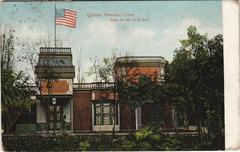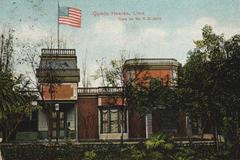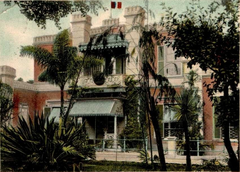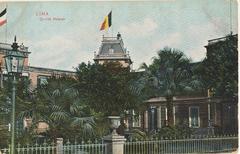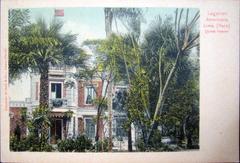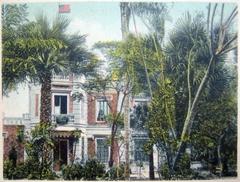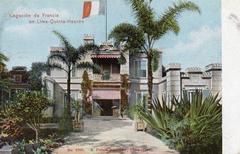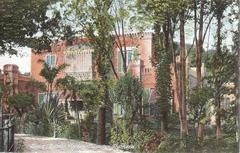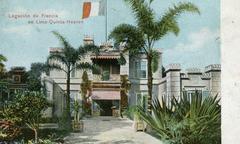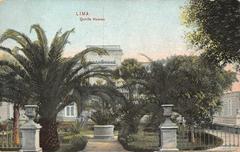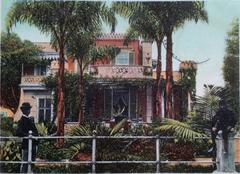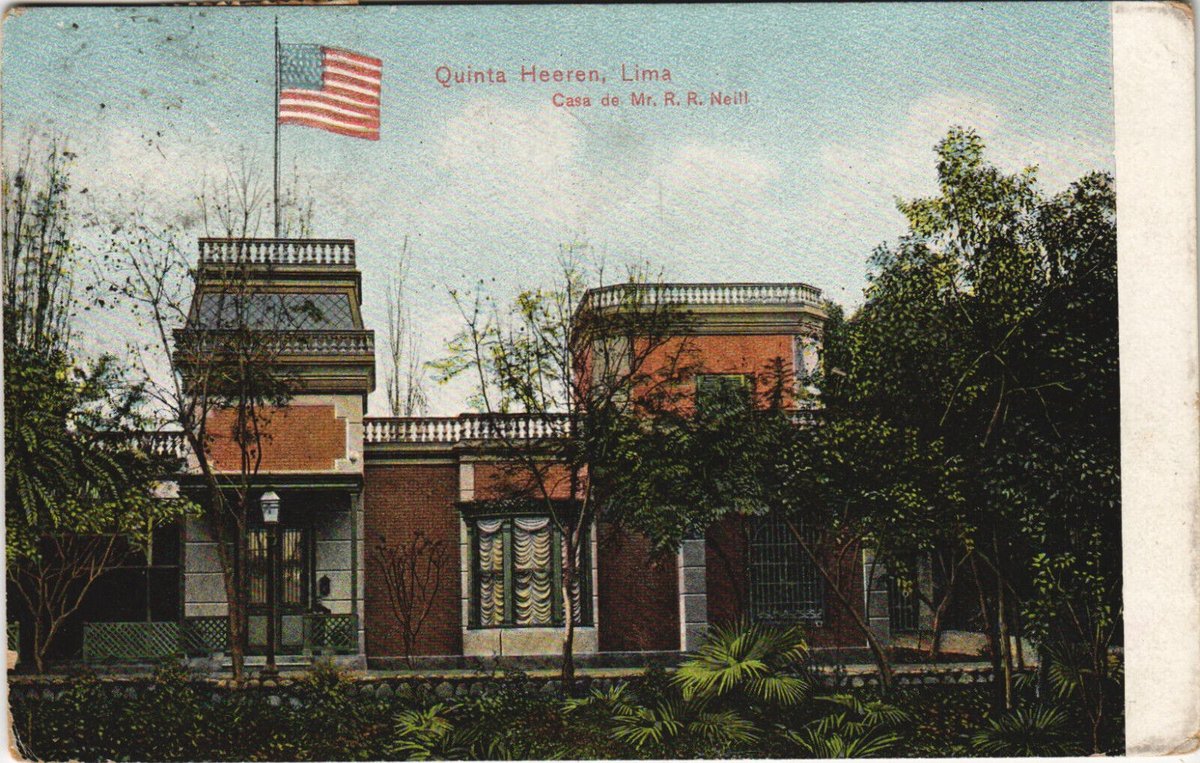
Quinta Heeren Lima: Visiting Hours, Tickets, and Historical Significance Guide
Date: 15/06/2025
Introduction
Quinta Heeren, nestled in Lima’s Barrios Altos district, stands as a vivid emblem of the city’s late 19th-century architectural innovation and cosmopolitan history. Commissioned by German entrepreneur Óscar Augusto Heeren and completed in 1886, this exclusive estate blends neoclassical, art nouveau, and Victorian design, introducing a European urban flavor to Lima’s aristocratic and diplomatic circles (Patrimoniando). Spanning approximately 40,000 square meters, Quinta Heeren was among the first luxury residential enclaves in Lima, with cobblestone streets, lush gardens, and ornate iron gates (El Comercio).
Quinta Heeren’s legacy includes its role as a diplomatic center, hosting embassies from France, Belgium, Germany, the United States, and Japan in the early 20th century (El Comercio). The estate also helped foster Lima’s artistic and musical movements, serving as the birthplace of the Lima Philharmonic Society in 1907.
Today, Quinta Heeren invites visitors to explore its unique blend of history, architecture, and culture through guided tours and cultural events. This guide offers everything you need to know: visiting hours, tickets, travel tips, accessibility, and safety considerations—ensuring a memorable and secure experience (Inca Trail Machu; La República).
Table of Contents
- History and Construction of Quinta Heeren
- Lima’s Historical Context in the Late 19th Century
- Cultural and Social Significance
- Architectural Evolution and Preservation
- Quinta Heeren Today
- Visitor Guide: Hours, Tickets, and Travel Tips
- Accessibility and Safety
- Nearby Attractions and Practical Advice
- Frequently Asked Questions (FAQ)
- Key Resources
History and Construction of Quinta Heeren
Quinta Heeren was the vision of Óscar Augusto Heeren, a German businessman and diplomat who arrived in Peru in the mid-1800s. Inspired by European urban design, he commissioned the estate as a gated residential enclave in the 1880s, with construction concluding around 1886 (Patrimoniando). The estate originally featured about 30 houses, organized around a central avenue and enclosed with decorative iron gates. Its eclectic architecture—mixing neoclassical, art nouveau, and Victorian elements—reflected Lima’s aspirations toward modernity and international sophistication.
Lima in the Late 19th Century
The creation of Quinta Heeren coincided with Lima’s recovery and transformation following the War of the Pacific (1879–1884). An influx of foreign investment and European cultural trends led to the development of new architectural styles and exclusive neighborhoods. Barrios Altos, once prestigious, saw enclaves like Quinta Heeren cater to diplomats, business leaders, and the Peruvian elite (El Comercio).
Óscar Heeren’s stature as a businessman and German consul helped forge connections between Lima and Europe, positioning the Quinta as a symbol of international prestige.
Cultural and Social Significance
Throughout its history, Quinta Heeren was home to diplomats, foreign merchants, and Lima’s influential families. The estate became known for elite social gatherings, cultural events, and diplomatic receptions (La República). Its cosmopolitan environment fostered cultural exchange and creativity, while its gardens and ornamental architecture became icons of Lima’s golden era.
Architectural Evolution and Preservation
Despite urban decline and demographic changes in the 20th century, much of Quinta Heeren’s original layout—cobblestone streets, gardens, decorative facades—remains intact (Patrimoniando). However, the estate has faced challenges from neglect and unauthorized modifications. Recent years have seen renewed preservation efforts, with restoration projects aiming to repair facades, recover gardens, and raise public awareness of the estate’s historical value.
Quinta Heeren Today
Quinta Heeren is now a vibrant, though less exclusive, residential community and a focal point for historians, architects, and cultural tourists (El Comercio). Guided tours and occasional cultural events showcase its architectural treasures and historical narratives, while ongoing revitalization projects seek to restore its former grandeur and enhance its role as a public cultural space.
Visitor Guide: Hours, Tickets, and Travel Tips
Location: Jirón Junín 1201, Barrios Altos, Lima, Peru (Inca Trail Machu; Wikipedia).
Access: Best reached by taxi or ride-hailing apps. Public transport is available, but private transport is safer due to the area’s security concerns (Supertravelr).
Visiting Hours: Quinta Heeren is open to visitors mainly through guided tours, typically organized on Sundays and for special events. Standard hours are Tuesday–Sunday, 9:00 AM–6:00 PM, but actual access depends on scheduled tours (Inca Trail Machu). Check the official Quinta Heeren Facebook page for tour announcements.
Tickets:
- Standard guided tour: S/20 (~US$5.50)
- Special events (with buffet, live music): up to S/60 (~US$18)
- Advance booking is recommended due to limited group sizes.
Guided Tours: Tours include architectural and historical commentary, visits to the main gardens and mansions, and stories about the estate’s legends and diplomatic past. Night tours focus on ghost stories and local folklore (Infobae).
Cultural Events: Quinta Heeren also hosts art exhibitions, live music, and theatrical presentations, often during special tours or festivals (Tierras Vivas).
Accessibility and Safety
- Safety: Barrios Altos is historically significant but can be unsafe, especially at night. Always visit with an official guided group, avoid valuables, and use registered transport (Supertravelr).
- Accessibility: The estate’s uneven surfaces and partial disrepair pose challenges for those with limited mobility. Restoration plans aim to improve accessibility, but check with tour organizers if you require accommodations (La República).
Nearby Attractions and Practical Advice
Quinta Heeren is close to several of Lima’s most iconic sites:
- Plaza Mayor
- Government Palace
- San Francisco Monastery
- Basilica Cathedral of Lima
- House of Aliaga
Combine your visit for a full day exploring Lima’s historic center.
Additional Tips:
- Wear comfortable shoes for cobblestones and uneven surfaces.
- Bring water and snacks; on-site amenities are limited.
- Photography is allowed but follow guide instructions regarding restricted areas.
Frequently Asked Questions (FAQ)
Q: What are Quinta Heeren’s visiting hours?
A: Guided tours are typically held Sundays at 10:00 AM; check the official Facebook page for current schedules.
Q: How much are Quinta Heeren tickets?
A: Standard tours cost S/20 (about US$5.50); special events may be more.
Q: Are tours available in English?
A: Most are in Spanish; inquire about English options when booking.
Q: Is the site accessible for people with disabilities?
A: Accessibility is limited due to uneven terrain; contact organizers for details.
Q: Is it safe to visit?
A: Only visit with official guided groups and use private transportation.
Key Resources
- Quinta Heeren Guide – Patrimoniando
- La Quinta Heeren: Un pedazo de Europa en Barrios Altos – La República
- El prometido regreso a la vida de tres casonas históricas de Lima – El Comercio
- Quinta Heeren Tour Lima – Inca Trail Machu
- El patrimonio cultural de Perú que desaparecería tras más de 100 años de historia – La República
- A Brief History of Quinta Heeren – Supertravelr
- Quinta Heeren Wikipedia
- Quinta Heeren Travel Blog – Tierras Vivas
Final Thoughts
Quinta Heeren is a distinctive landmark where Lima’s European-inspired architectural legacy meets its vibrant Peruvian heritage. Whether you’re captivated by its aristocratic past, intrigued by its legends, or eager to support its cultural revival, a visit to Quinta Heeren promises a memorable journey into the heart of Lima’s history. For the most up-to-date information on tours and cultural events, follow official channels and consider using tools like the Audiala app for self-guided exploration.
